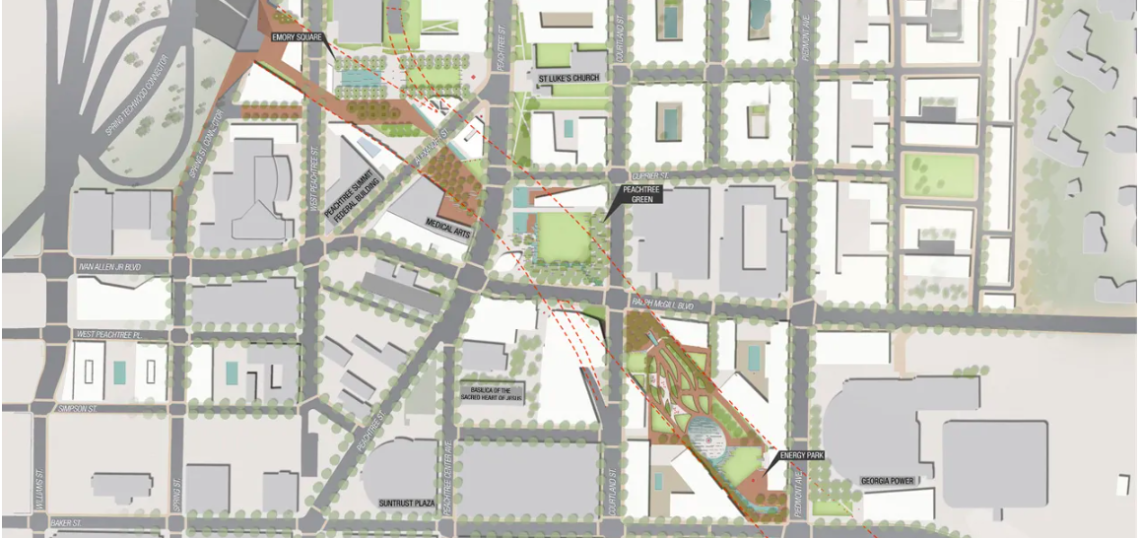Like Rome, downtown Atlanta’s highway-capping park wasn’t built upon on nonexistent land in a day. And it probably won’t be completed for the next 10 years, either.
That didn’t stop a congresswoman and downtown boosters from effusing optimism during a Thursday press conference that Atlanta’s so-called Stitch is going to happen, as the project officially picked up its largest federal contribution to date.
U.S. Rep. Nikema Williams, D-Atlanta, announced a $1.16 million federal investment in the Stitch as part of a new program that allows legislators to request funding for communities they represent. It marks the first funds acquired for the Stitch during its engineering phase, according to Williams’ office.
Still, it’s a drop in the bucket for the hundreds of millions that would be required to pull off the Stitch.
Williams, a member of the House Transportation and Infrastructure Committee, predicted the highway-capping park project will “improve everyone’s quality of life” by reclaiming a “massive part of our city with a beautiful new greenspace, [that mitigates] environmental damage from highway traffic, and [builds] dignified affordable housing,” according to a statement. The Stitch, Williams believes, will help unstitch almost seven decades of injustice.
“The downtown Connector was built as part of the 1956 Federal-Aid Highway Act, which intentionally divided Black communities across the country,” said Williams. “It was racial injustice plain and simple. While we can’t and don’t seek to remove the Connector, I can take steps to undo the damage it has caused—starting with reconnecting our communities.”
 As seen in winter 2018, the Stitch would cap this 3/4-mile section of the Connector with greenspace, from the Civic Center MARTA station to just east of Piedmont Avenue. Courtesy of Jonathan Phillips
As seen in winter 2018, the Stitch would cap this 3/4-mile section of the Connector with greenspace, from the Civic Center MARTA station to just east of Piedmont Avenue. Courtesy of Jonathan Phillips
Central Atlanta Progress, the Stitch’s spearhead since its inception back in 2016, estimates the project could take a decade to fully construct and open over the Connector, near the point where downtown’s northern blocks meet Midtown. The estimated price tag has swelled to more than $700 million.
Construction could begin by 2024 or 2025, with an estimated completion at the earliest in 2032. Recent progress with the long-delayed Atlanta Civic Center redevelopment, located just a block away, could make the Stitch more timely, CAP officials said last month.
On the bright side, more federal cash for the Stitch could be in the offing, as the Atlanta City Council is pursing another $10.5 million to help fund preliminary engineering via the federal Reconnecting Communities Pilot program. Another $10 million from city coffers would match that federal contribution, too. Results are expected to be announced in early 2023, with grant funding disbursement to follow.
Stitch’s plans call for 14 acres of plazas, paved trails, and greenspace elevated over the I-75/I-85 Connector. In theory, it would restitch downtown and Midtown back together after nearly 70 years of being cleaved apart by expressways. It would stretch for about three-quarters of a mile between the Civic Center MARTA station and just east of Piedmont Avenue.
 Early plans for potential uses around the Stitch park. Courtesy of Atlanta Downtown Improvement District/Central Atlanta Progress
Early plans for potential uses around the Stitch park. Courtesy of Atlanta Downtown Improvement District/Central Atlanta Progress
The Stitch, if fully realized, would be almost as large as 16-acre Rodney Cook Sr. Park, which opened last year in Vine City on the flipside of downtown. It’s one of three major highway-capping proposals in the city currently in fundraising mode. The others are Buckhead’s HUB404 and the largest by far, the Midtown Connector.
Jack Cebe, an engineer with experience in landscape architecture and roadway design, was appointed Stitch development manager in June. Cebe estimated this week the project could catalyze and support 3,000 new affordable housing units and 14 million square feet of development, helping to “mitigate the wrongs of the past” and “improve livability and the downtown value gap.”
• Downtown news, discussion (Urbanize Atlanta)






